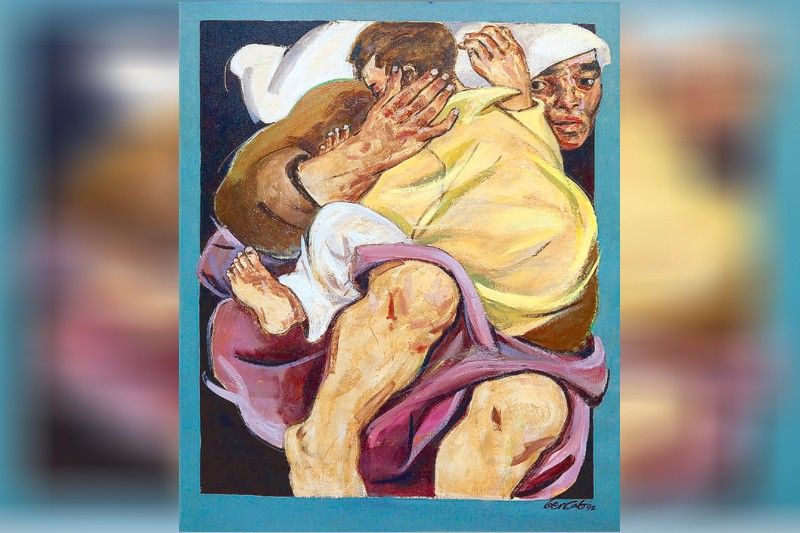Unknown Heroes and Famous Heels


Every last Monday of August, we now celebrate National Heroes Day. It’s not only to give honor to the nameless many who gave their lives for our country but also, as one past Philippine president put it, to boost the “holiday economics” of the pre-pandemic long weekend. And so it goes with our own nation’s checkered history.
There are plenty of heroes and heels, unknown and famous, to be found at the upcoming León Gallery Magnificent September Auction, scheduled to take place Saturday, Sept. 19, 2 p.m. at its Eurovilla I sale rooms. The event is the second major alliance between the country’s most trusted auction house and ANCX.ph, the lifestyle site of ANC, aka the ABS-CBN News Channel.

In the Western world, the Philippines officially hove into view with the arrival of Ferdinand Magellan 499 years ago. Among the troves on offer is the renowned Chatelain Map. It’s a wall-sized rendition of the Magellan-Elcano circumnavigation of the world along with the glorious paths taken by such great explorers as Columbus, Vespucci, Drake and Dampierre.
Of course, you can’t mention the name Magellan without remembering the man who cut him down in the shallow waters off Mactan. The thought, however, usually leaves Spanish scholars frothing at the mouth at Lapu-Lapu’s so-called indio impudence. One of the recent, rather unfriendly essays dared wonder if our first warrior hero could represent Filipino courage since, it argued, the King after which we were named hadn’t even been born yet. That misses the point, of course, since one needs neither cedula nor passport to love one’s country and fight off foreign interlopers. What can you expect, of course, when peninsulares hold a 499-year-old grudge?

Another map sets the record straight about the first-ever European document to feature the name “Filipina” as the name for our beloved home country. Known as the Ramusio-Gastaldi Map of 1563, it is the “birth certificate” of our Mother Land, the Inang Bayan of patriotic poetry and prose. (A map slightly older, circa 1565, brought the hammer price of P3 million at León Gallery just earlier this year.)
Our next favorite hero is Fernando Amorsolo who was one of the six men to graduate from the first class of the University of the Philippines’ College of Fine Arts in 1914. He would be mentored not just by his uncle, the fabled Fabian de la Rosa, but later also by that titan of illustrators, Jorge Pineda. The turning point of his art, however, came when he discovered the painter Joaquin Sorolla while in Madrid for further studies. One of the auction highlights is a painting of a bare-breasted maiden offering a bouquet of flowers to a heathen god. She was painted by Amorsolo in 1945. It is perhaps one of the first untroubled works created after his series of horrific landscapes of war-torn Manila.

A painting of Juan Luna, titled “View of Mariquina,” is an intense landscape of the green fields and mountains of this town, itself a microcosm of the families and politics of the Philippines, readily peopled by heroes and anti-heroes. The Hacienda Mariquina would become the stuff of legend, including word that the land covering “as far as his horse could take him” was given as the country’s only noble estate to the Tuason patriarch.
Luna was a shattered man when he produced this masterpiece that recalls the wild moors of Wuthering Heights. He had just been acquitted of murdering his wife as a result of what the French court reckoned were his primitive instincts. Indeed, one can sense his brooding unease on the canvas. (Ironically, the man who would recommend the official spelling “Marikina” for this picturesque town to the Philippine Commission would be Luna’s brother-in-law, Trinidad Pardo de Tavera. He was the fellow Luna would wing with a bullet on that same tragic Parisian afternoon when his wife was shot.) Returning to the Philippines to mend and paint, Luna would soon be arrested once again, this time with his brother Antonio for suspected complicity in the Philippine Revolution. Both times he would rely on his fame as a celebrated painter and his friendship with the Queen Mother Maria Cristina to escape a terrible fate.
Another gorgeous landscape, titled “Angeles,” is by National Artist José Joya, capturing more of the azure skies above and reflected below in the Pampanga rivers and ponds. Joya was the first Filipino painter to represent the country at our very first outing at the Venice Biennale in 1964.

Mark Justiniani, on the other hand, is the most recent one to bring fame and honor to the Philippines in the last Venetian art event. One often forgets that Justiniani was (and is) an artist who sees the world through the prism of politics. (He was a founding member of the consciousness-raising collective called Sanggawa, elsewhere represented with a powerful work in the Magnificent September auction.) In the aptly named “Mano Po,” Juan de la Cruz touches his forehead reverentially to Uncle Sam. There’s no mistaking Justiniani’s message here.
In the kingdom of the north, BenCab reigns supreme, this time with a chronicle of the consequences of the infamous Baguio earthquake in 1990. “Boy Afraid of Tremors” is a moving snapshot both of the trials and triumphs of the men and women of that city as they braved the many aftershocks.
Finally, a major José John Santos III work makes a rare appearance at auction. “Through the Peep Hole” was one of the representative works of the Philippines at the 20th Asian International Art Exhibition 2005. It represents not just the politics between men and women, but also the past and present, our intentions and reality.
May we all, therefore, always have a happy proportion of heroes and heels in our lives, even if they are to be found only on our walls.

* * *
View the online catalogue as well as register to bid now at www.leon-gallery.com. For inquiries, call 8856-2781 or send an email to info@leon-gallery.com.






















